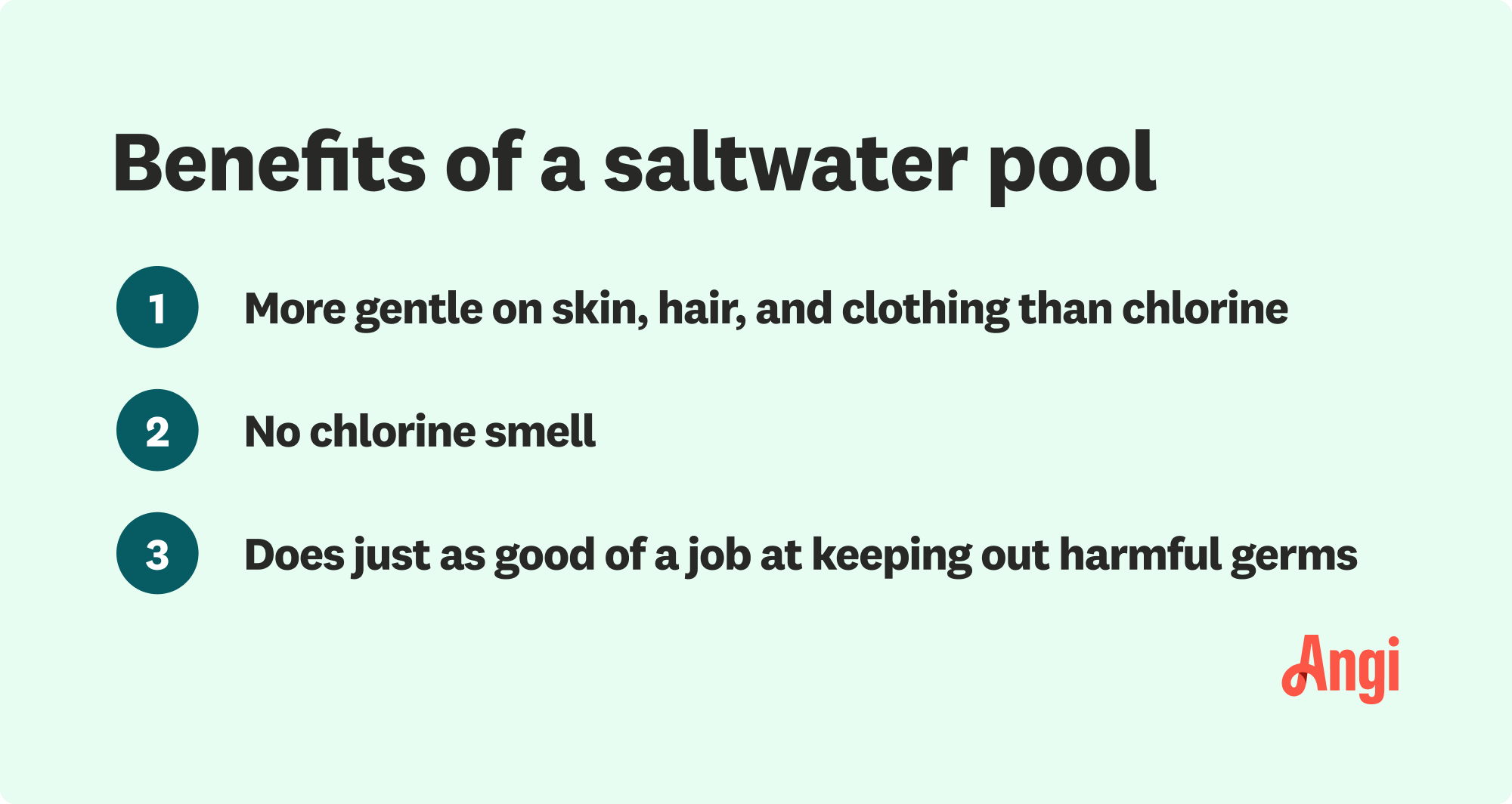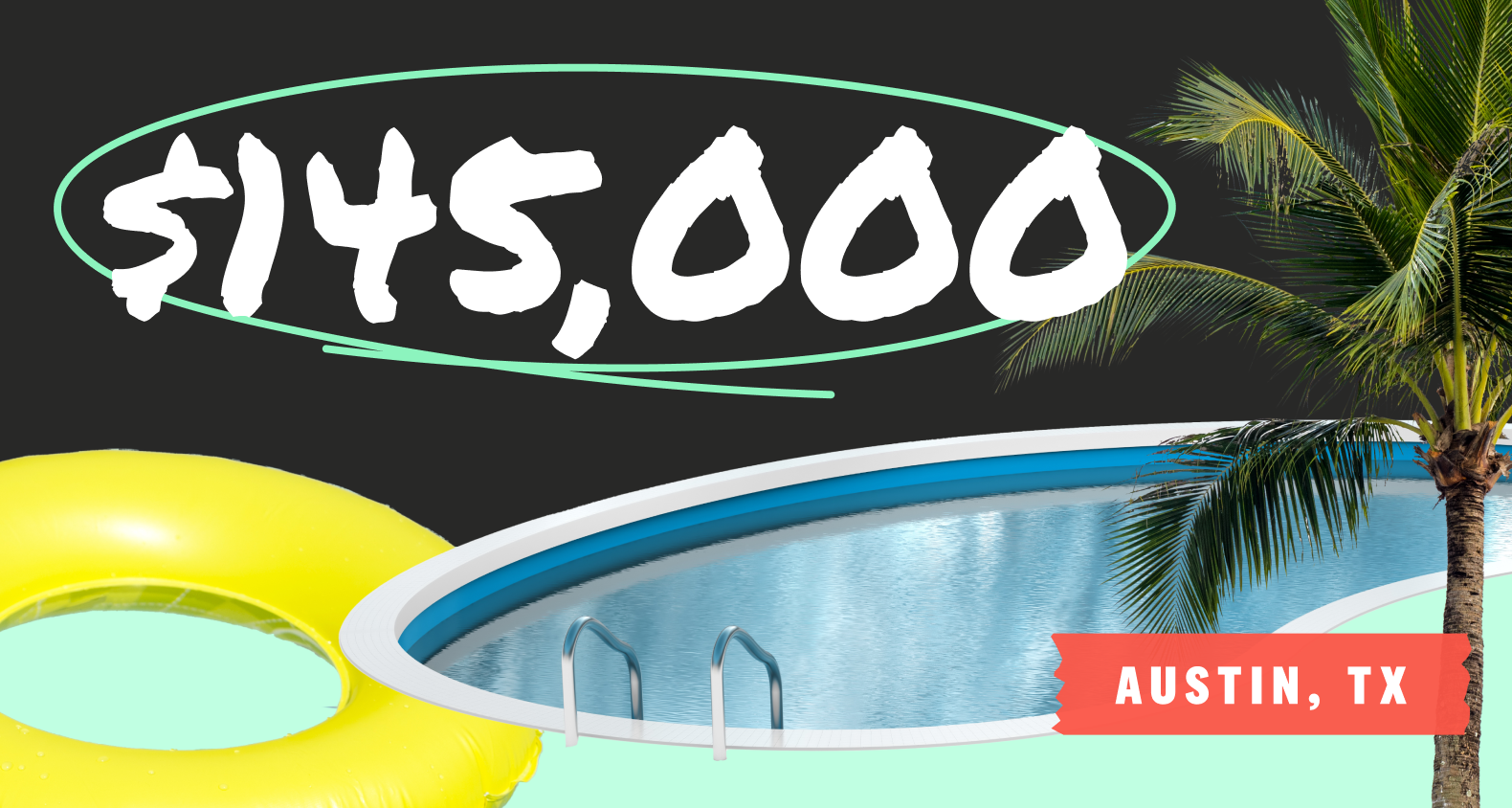How Much Does a Salt Water Pool Cost to Install? [2025 Data]
A salt water pool costs $25,000 on average, with prices ranging from an average of $12,000 to $38,500. However, you'll spend a lot less money to convert an existing pool into a salt water pool.


Installing a new salt water pool costs an average of $25,000, with a typical range of $12,000 to $38,500 (only slightly more than a chlorine pool). However, it may cost as little as $500 if you already have a pool and want to convert it to a salt water system—which might make you less salty about the steep price tag to install a salt water pool.
Salt Water Pool Cost Factors

There are several costs associated with installing a salt water pool: the installation of the pool, the cost of a salt water chlorination system, the size and material of the pool, and the cost to fill the swimming pool with water.
Salt Water Pool Installation vs. Conversion
Salt water pool installation costs will differ significantly depending on whether you’re putting in a new pool or simply converting an existing pool.
Installing a New Pool
Installing a brand-new pool will be a lot more expensive since you’ll have to hire contractors to dig the space for the pool and build it. As a result, the average cost of installing a salt water pool ($25,000) is slightly more expensive than the average cost of installing a chlorine pool ($23,000).
Cost of Converting a Chlorine Pool to a Salt Water Pool
In this situation, homeowners spend about $500 to $2,500 on the cost of a salt water pool chlorination system. Since the lion’s share of the cost of installing a salt water pool comes down to the actual installation cost of a pool and not the water in it, you can save a lot of money by simply converting a chlorine pool into a salt water pool.
Inground vs. Above Ground Salt Water Pool
The cost to convert an above ground pool to a salt water pool is less than converting an inground pool. This is because the chlorine generator—AKA the part you’ll need to swap—for an above ground pool is less expensive than that of an inground pool. That being said, it is worth browsing the inground pool companies near you to find the best possible price for converting your pool into a salt water pool.
Pool Material
You can build an inground salt water pool out of a variety of construction materials. Different materials vary in price, and some work better with salt water generators than others. Consider your choice carefully to avoid needing major renovation work a few years after installation.
| Pool Material | Average Cost |
|---|---|
| Concrete | $50,000–$200,000 |
| Vinyl | $20,000–$63,000 |
| Fiberglass | $9,000–$40,000 |
The most common types of pools include:
Concrete: Salt can be rough on this porous pool material, which costs $50,000 to $200,000.
Vinyl: This material has a customizable steel frame that requires maintenance to prevent rust from salt water. Expect a cost of $20,000 to $63,000.
Fiberglass: These shells come at $9,000 to $40,000 with little risk of damage from salt.
Pool Size
The size of any pool significantly impacts its installation cost. This is true even if you're converting an existing chlorine pool into a salt water pool. Larger pools require more expensive salt water chlorinators, and their ongoing costs will include higher amounts of salt. Most standard pools are at least 12-by-14 feet in size, and prices for other common sizes are listed below.
| Pool Size | Average Price Range |
|---|---|
| 10-by-16 ft. | $15,000 – $26,000 |
| 10-by-30 ft. | $24,000 – $42,000 |
| 12-by-24 ft. | $27,000 – $50,000 |
| 14-by-28 ft. | $37,000 – $55,000 |
| 16-by-32 ft. | $48,000 – $70,000 |
Salt Water Chlorination System
You will pay between $500 and $2,500 for a salt water chlorination system, with the cost largely determined by how big your pool is.
Filling the Pool With Water
The cost of filling a swimming pool with water is between $60 and $1,250, depending on the size of the pool.
Site Prep
Preparing the site for the salt water pool installation involves clearing anything that’s in the way, like tree roots and large rocks, as well as excavating the land to make a hole for the pool. The cost of site preparation depends on the size of the site and whether it's easy to access. On average the pool excavation cost is $3,400, but it can go up to as high as $20,000 depending on the land itself.
Pool Pump and Filter Installation
It is vital to have a pump and filter system for your salt water pool. For an inground salt water pool, the pump and filter system typically costs between $700 to $1,000. For an above ground salt water pool, it costs around $500 and up.
Location
Location factors into the salt water pool cost in two ways—geographic location and location within your yard. As previously mentioned, whether the proposed installation site is easily accessible can up the costs of site preparation. Additionally, the cost to install a salt water pool depends on the region in which you live. For instance, labor rates may be higher due to higher demand in regions with more consistent warm weather.
Cost of Pool Salt
You'll need to add salt to your salt water pool regularly. You can buy salt in bulk or spend around $10 to $40 for a 40-pound bag. On average, that's $0.25 to $0.63 per pound. You'll need one bag for every 2,000 gallons of water during your initial pool conversion. A small pool may only require two bags, while a large one may require seven or more bags.
Pool Heater
Expect to pay $1,600 to $3,800 for the cost of a pool heater, and you'll also need to spend another $70 for a corrosion-resistant check valve for your salt water system.
Ongoing Salt Water Pool Costs

Salt water pools, like any pool, require regular cleaning, maintenance, and other ongoing costs to keep them operating properly.
Salt Water Pool Maintenance Cost
Knowing how to maintain a salt water pool is important and luckily, adding salt is the only monthly maintenance you'll need to do for a salt water pool. Most salt generators only need a concentration of salt between 2,800 and 3,500 parts per million. You'll need to regularly test the salt level in your pool water and add salt accordingly.
Cleaning Costs
Salt water pools are low maintenance compared to traditional chlorine pools. They generally only require manual debris removal with a net skimmer and telescoping pole. You can get these tools for $25 to $65 from your local home improvement store.
Cost of Common Salt Water Pool Add-Ons
When comparing salt water pools vs chlorine pools, you’ll find that they both lend themselves to add-on features, whether recreational or practical. Here are some of the most common salt water pool add-ons and how much they typically cost.
| Add-On | Cost |
|---|---|
| Waterfall | $1,500–$5,000 |
| Pool Cover | $100–$3,000 |
| Diving Board | $300–$5,000 |
| Fence | $1,500–$10,000 |
| Decking | $3,000–$12,000 |
| Slide | $1,500–$5,000 |
How Much Does a Salt Water Pool Cost to Install Yourself?
It costs $300 to $500 for labor to install a salt water chlorination system, so that's how much you could save if you decided to do the job yourself. However, it's a more difficult job than you think: You have to access the guts of your system, cut through pipes, and go through a complicated installation process. Unless you have experience, it's probably not worth saving a few hundred bucks.
If you're talking about installing a whole new pool, it's an even worse idea to DIY it. Even if you had the experience and the equipment for the job, it is not a one-person project. Still, a good rule of thumb is that labor will take up about half the cost of building a pool. Instead, contact a pool installation professional near you and ask for a quote. The project may cost less than you think.
Tips to Reduce the Cost of a Salt Water Pool
If you're decided on getting a swimming pool but balk at the huge cost of installing a brand-new pool, you can invest in the cost of an above ground pool instead—which is more affordable than an inground pool. You can install a salt water chlorination system for these as well.
You can also save money by being willing to scale down the pool size until it fits within your budget. Or, if a custom-shaped pool drives up the cost, you can go for a more standard-shaped rectangular pool.
Another option is to opt for a vinyl pool rather than fiberglass or concrete, which tends to be more expensive. You may have to replace it earlier, but it should still last for years.
Finally, consider holding off on some of the features you were thinking of adding along with the pool. Maybe install a spa down the road or scale down your landscaping plans.
Nick P. Cellucci contributed to this piece.
Frequently Asked Questions
Yes, salt water pools are more expensive than chlorine-based pools because they require a more complex system than traditional, chlorinated pools. This added complexity means more skilled labor and a higher investment upfront. Also, if you need to repair a salt water pool, finding a contractor with the needed experience is generally more time-consuming.
It takes more electricity to run one, so it’s not necessarily cheaper to run a salt water pool. However, the cost difference is relatively minor; it may cost an extra $50 over the course of a year. However, salt costs a lot less than chlorine sanitizers. This lowers the overall maintenance costs for a salt water pool compared to chlorine pools.
While salt water pools are slightly more expensive to install and run, they offer a better experience with less irritation to the skin, eyes, and even hair. Salt water is also less harsh on swimsuits and pool accessories. As a result, some homeowners feel the extra expense is worth it.
There are some disadvantages to a salt water pool. Besides costing slightly more than chlorine pools, salt water pools require a lot of salt. It's also harder to find a professional with salt water pool experience to do minor maintenance and repairs. Salt water can also damage some materials, so you’ll need to use specific heating, fixtures, lighting, liners, and masonry when building a salt water pool.
A salt water pool may need resurfacing as often as every three to seven years. This is more than a chlorine pool, which you’ll need to resurface every 10 years. Look out for wear and tear on your pool's finish, and don't ignore damage when you see it. Resurfacing a pool costs less than dealing with erosion from pool leaks.





- Swimming Pool Installation
- Pool Liner Replace & Install Companies
- Above Ground Pool Contractors
- Pool Remodeling Companies
- Inground Pool Companies
- Pool Removal Companies
- Inground Pool Repair Companies
- Sauna Companies
- Hot Tub Companies
- Sauna Repair
- Fiberglass Pools
- Pool Designers
- Pool Pump Repair
- Pool Closing Services
- Solar Pool Heater Installers










